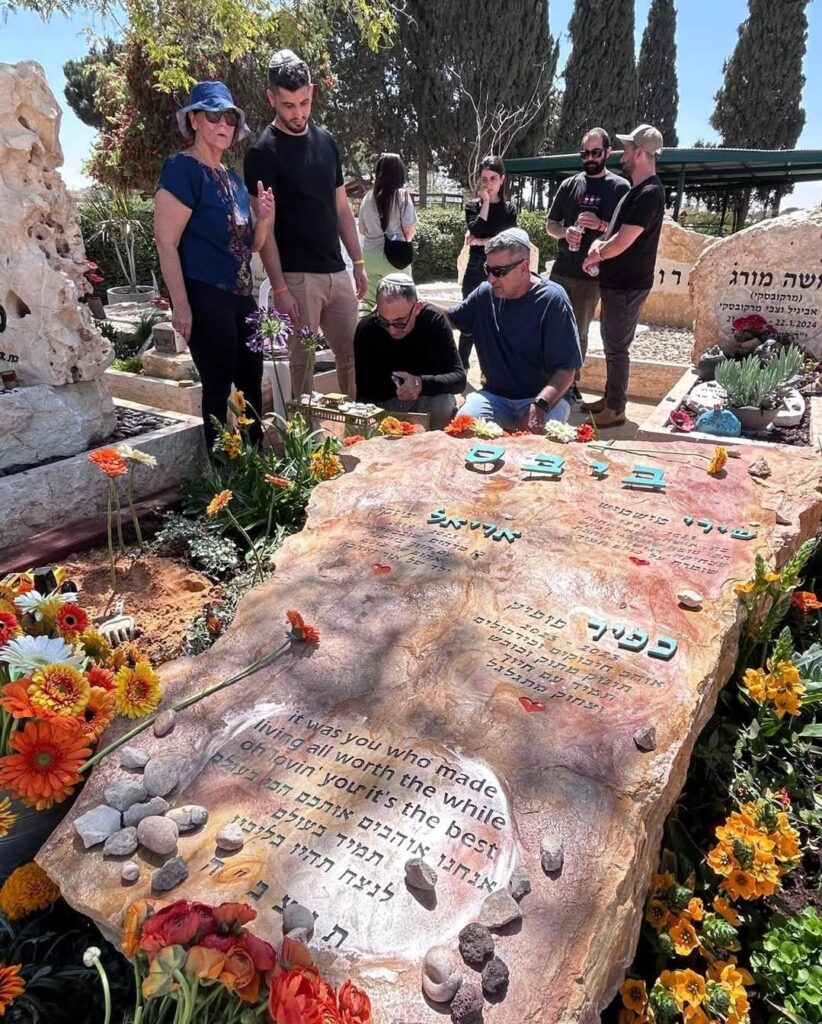|
Getting your Trinity Audio player ready...
|
Matzeiva Placed for Shiri Bibas and Her Children, HY”D: A Nation Mourns, Remembers, & Holds Fast to Their Memory
Edited by: Fern Sidman
A month after their kevurah in southern Eretz Yisroel, a matzeiva has now been erected t the resting place of Shiri Bibas Hy”d, and her two young sons, Ariel and Kfir Hy”d, who were murdered in Hamas captivity following their brutal abduction from Kibbutz Nir Oz on October 7. As reported by Yeshiva World News (YWN), the unveiling of the matzeiva is both a sacred moment of grief and a national symbol of resilience.
30 יום לקבורתם של שירי, כפיר ואריאל ביבס. הוצבה מצבה משותפת, סלע בגווני כתום.
ליד כל שם על המצבה נכתב שם החיבה. שירי נכתב: בת אישה אמא ואחות הכי טובה שיכלנו לבקש, מצחיקה רגישה אוהבת ושומרת על כולם תמיד.
כפיר: אוהב חיבוקים וכירבולים, תינוק מתוק וכובש.
אריאל: בן מדהים ושובב עם… pic.twitter.com/8l0BgEF3KQ— אסף פוזיילוב (@pozailov1) March 27, 2025
The Bibas family’s story became one of the most widely recognized and emotionally searing in the aftermath of the massacre carried out by Hamas terrorists on Simchas Torah. Shiri, along with her husband Yarden and their two sons, was taken hostage in Gaza. While conflicting reports plagued the public discourse for months, it was eventually confirmed that Shiri, Ariel, and 10-month-old Kfir had been killed in captivity. Yarden Bibas was released from Hamas captivity and eulogized his wife and two sons at their funeral.
As detailed in the Yeshiva World News report, the matzeiva at their gravesite is tinged with a subtle orange hue — a poignant tribute to the children’s vibrant orange hair, which became an emblem of public solidarity and collective prayer in Israel and Jewish communities worldwide. The image of Ariel clutching baby Kfir in his arms, with Shiri beside them, had become an unforgettable symbol of the hostages’ plight. The color orange soon came to represent their story, adorning posters, prayer circles, and protests demanding their release.
Now, that same hue gently colors the stone marking their final resting place — a visual continuation of the identity that touched millions.
The kever is inscribed with their full names, cherished nicknames, and heartfelt epitaphs reflecting the depth of the family’s loss. One English phrase etched into the stone stands out for its emotional simplicity and universal resonance: “It was you who made living all worthwhile, oh lovin’ you it’s the best.”
It is a line that expresses the overwhelming grief of a family robbed of its future, and a nation mourning lives that could have blossomed in peace.
As reported by Yeshiva World News, the Bibas family’s ordeal stirred the conscience of Israelis and Jews globally. From prayer vigils to protests at the Red Cross, their names were chanted, their faces emblazoned on signs, and their story was told again and again — a symbol of innocence amid unspeakable cruelty.
The orange-haired Bibas boys, in particular, captured the hearts of countless people who clung to the hope that they might one day be returned safely. That hope was tragically extinguished when Israeli intelligence confirmed their deaths, attributing their murder to Hamas during captivity in Gaza — a revelation that sparked national mourning and renewed demands for international accountability.
Though the matzeiva brings a measure of finality, the pain it represents is immeasurable. The placement of a stone — a Jewish tradition marking the permanence of memory — becomes, in this case, a collective gravestone for a chapter of history that will be remembered for generations.
The very existence of such a matzeiva speaks to both the inhumanity of the captors and the dignity of the victims. In the words of one mourner quoted by Yeshiva World News, “Their light was stolen, but their memory cannot be.”
In the ever-growing landscape of grief that followed October 7, the Bibas family became a symbol of what was lost — and what must never be forgotten. As Yeshiva World News has faithfully documented, the placement of this matzeiva is not merely the closing of a chapter, but a sacred declaration: that the lives of Shiri, Ariel, and Kfir Hy”d mattered — and will continue to matter for eternity.




